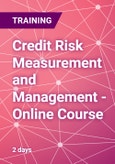Course description
The course will give you detailed knowledge of how to manage credit risk and which techniques are employed. You will learn how to estimate and use the cental credit risk parameters: PD, EAD, LGD, and WCDR. You will also learn how they are used in assessing the capital requirements. You will work with credit risk models like KMV Moody’s and CreditMetricsTM in Excel.
How is the online course conducted?
Great emphasis is placed on interaction. Therefore, the training will be a combination of recorded training, exercises, and guidance. The course includes:
- A recorded class room training without participants, where you will get exercises and solutions as part of the training.
- Possibility to ask questions and get answers within 24 hours.
- Two months access to the course. You decide when and at what pace you want to follow the recorded training.
- A training that is suitable for viewing on both computer and mobile.
You must set aside approx. 2 working days for the course.
Course content
- Credit Risk Modelling
- Credit Risk and Capital Requirements
- Managing Credit Risk using Credit Derivatives
- KMV Moody’s
- CreditMetrics
- CreditRisk +
- Counterparty Risk
- CVA, DVA, FVA and BCVA
- Stresstesting
- Basel IV
Course Content
Chapter 1 - Introduction to Credit Measurement and Management- Overview of types of credit risks
- Approaches for measuring credit risk
- Granting credit - the process
- Recommendation on credit risk management
- Probability of Default (PD)
- Exposure at Default (EAD)
- Loss Given Default (LGD) and Recoveries
- Correlations
- Maturity (M)
- Calculation and Interpretation
- Characteristics of credit risk
- Use of credit risk models
- Requirements of a credit risk model
- KMV Moody’s
- CreditMetrics
- CreditRisk+
- Portfolio credit risk
- Marginal credit risk
- Advantages and disadvantages of the various models
- Workshop - calculating credit risk using the various models
- Counterparty risk versus traditional credit risk
- Key counterparty risk numbers
- ”Risk neutral” or ”real world” pricing
- Approaches to measuring counterparty risk
- Simple, analytical, or Monte Carlo Simulation
- Methods to reduce counterparty risk and requirements from EMIR
- CVA, DVA, FVA, and BCVA
- Accounting or regulatory use
- Workshop - calculating and interpreting Potential Future
- Exposure and CVA
- Standard method
- IRB-method
- Foundation or advanced approach
- CVA-charge on derivatives
- Workshop - calculation of capital requirements
- Overview of credit derivatives
- How the market works
- Using CDS-contracts to reduce risk
- Pricing
- Risks
Who Should Attend
- Risk Managers
- Risk Controllers
- Analysts
- Backoffice Employees
- Internal Auditors
- Financial Authorities
- IT-employees
- Operations
- Compliance
- Account Managers








